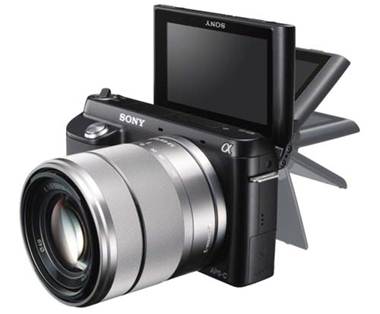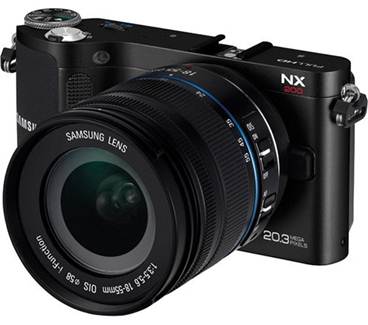Ratings: 4/5
Price: $699 (SEL 1855 lens); $999 (SEL 1855
& SEL 55210 lenses)
www.sony.com

Sony
has targeted the user without experience
Sony has mastered the art of ‘compact’ in a
compact system camera. The NEX-F3 body is positively tiny when compared to some
of the other cameras on test.
The compact design doesn’t come at the
expense of image quality, though. Sony has packed a whopping great 16.1
megapixel APS-C sensor inside the F3, which means pretty impressive colour
reproduction and image clarity. Dynamic range does struggle a bit in auto
modes, though with bright sections of the shots tending to almost always blow
out.
The 3in LCD is amazingly clear and vibrant
and conveniently flips up 180 degrees for self-portraits, which isn’t something
many CSC or DSLR cameras will let you do comfortably.
The trouble with the Sony is the menu
system. If you look at the back of the NEX camera, you’ll be pleasantly surprised
by its simplicity – there are very few buttons and an almost complete lack of
dials. But that means that almost everything is buried within the menu system,
including choosing which shooting mode you wish to use.
This is far from a deal breaker and instead
indicates that the best audience for the F3 is novice users. While the Olympus
and Panasonic cater to a more experienced photographer, Sony has targeted the
user without experience. Even the way the camera adjusts things like aperture
is by demonstrating the effect through images rather than confusing f-stop
numbers.
That approach is reinforced by the fact
that every change in setting has an explanation bubble pop up, as well as by
fun features like sweep panorama and Toy Mode. Sony’s filters are impressive
with something a bit more artistic than they might normally try.
Buying advice. This is not really a camera for a keen photographer who already
knows their way around complex settings. But for compact users looking to step
up, the NEX-F3 is hard to beat.
Samsung NX-200
Ratings: 3.5/5
Price: 4799 (18-55mm lens)
www.samsung.com

Samsung
NX-200
Samsung’s engineers really are a clever
bunch of people. Realizing that photographers almost always hold the lens of a CSC
or DSLR camera to balance the weight, they introduced a simple control
mechanism on the lens to make quick adjustments to settings.
The i-Function lenses are really a standout
feature for the NX-200. While the compact body lacks many of the features and
dials of a full DSLR, by adding the ability to adjust practically anything,
including shutter speed and aperture, on the lens Samsung has managed to
counter the need to hide the camera’s functions deep within menus.
It’s also one of the camera’s biggest weaknesses,
as the selection of lenses on offer with i-Function compatibility is severely
limited.
The 3in AMOLED viewer is stunning, able to
show your shot even in the brightest sunlight. It’s fixed in place, though, so
there’s no easy viewing from difficult angles.
Unlike many of the other cameras tested,
the NX-200 doesn’t have its own dedicated video button; instead this is
selected on the mode dial. The Full HD video recording through the
20.3-megapixel sensor is fantastic at 30 frames per second.
The camera lacks an in-built flash, instead
requiring use of the hotshot on the top of the camera. While that’s not an
issue in itself, you can’t use a flash and a viewfinder at the same time.
Despite being able to crank up to 12800,
it’s really too noisy to be functional. Which is disappointing given the
camera’s image stabilization is done in the lens and not every lens offers
stabilization.
Buying advice. Impressive from a technical standpoint and image quality is
fantastic. But the limited selection of i-Function lenses hold it back.
Olympus OM-D E-M5
Ratings: 4.5/5
Price: $1199 (body only)
www.olympus.com
`
The
OM-D makes framing your shot almost too easy
Olympus helped create the CSC category when
it partnered with Panasonic to come up with the Micro Four-Thirds standard back
in 2008. Its latest offering is by far its best, combining state-of-the-art
technology and some classic retro design.
With a stunning foldout 3in touchscreen LCD
that lets you choose the precise point of focus for your photos, as well as a
crystal-clear electronic viewfinder, the OM-D makes framing your shot almost
too easy.
Although the wide collection of buttons and
dials may be a little daunting for the novice photographer, the ability to view
each setting change on the camera’s screen will help overcome any unfamiliarity
with the manual setting mode.
The inclusion of multiple dials for
controlling different settings when shooting manual will be welcome for any
photographer who understands how to get the most out of their camera.
Olympus has given the OM-D a five-axis
image stabilization, which is easily the best of any camera tested. The extra
stabilization allows photographers to use longer shutter speeds without the
need of a tripod, which helps make handheld night shooting a much less blurry
proposition.
Special art filters offer an artistic
quality to photos although, as most professional photographers know, it’s
better to shoot in RAW and add effects later. Fortunately, bundled software
lets you do just this, although it doesn’t work if you shoot exclusively in
JPEG.
The biggest frustration with the OM-D isn’t
so much the large number of buttons on the camera, but the fact that some of
them are tiny and awkward to press. Most notable of these is the playback
button, which is a tiny, slightly spongy button on the back, which feels a bit
awkward to press.
Macworld’ Australia’s buying advice. A superb camera that’s supported by a wide range of lenses and
accessories, the OM-D is the perfect CSC for DSLR users looking for a
lightweight companion camera.